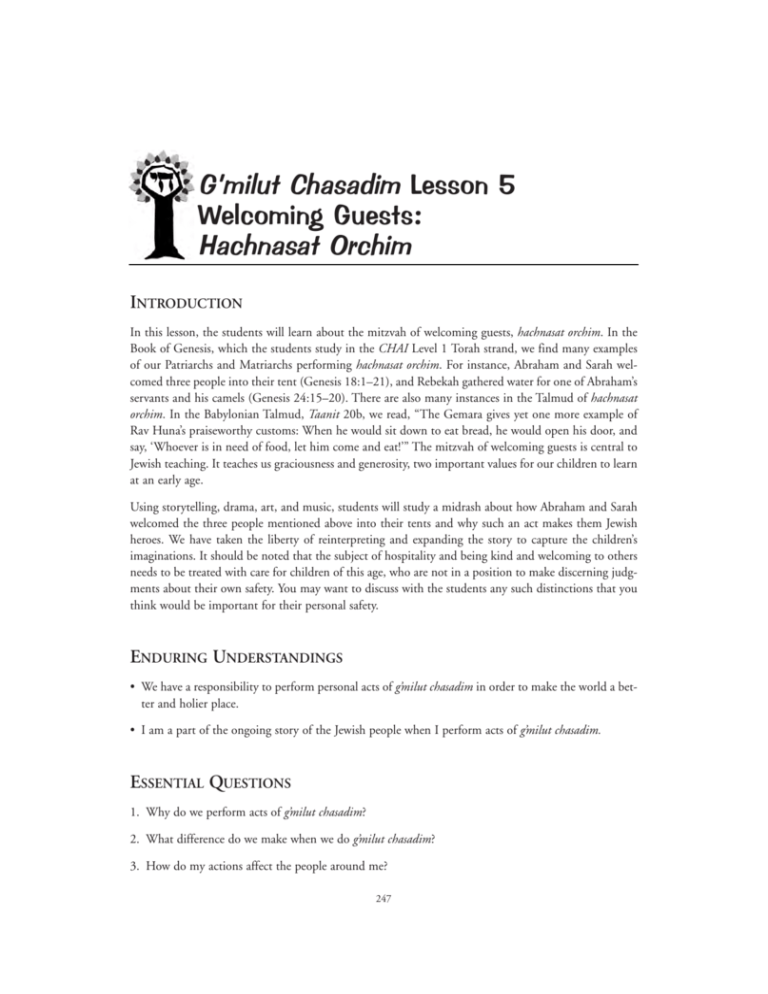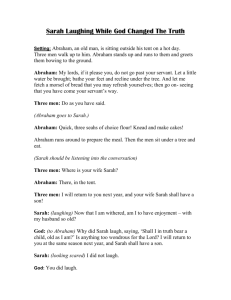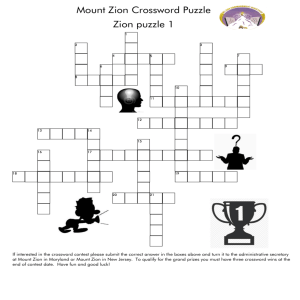Lesson5
advertisement

G’milut Chasadim Lesson 5 Welcoming Guests: Hachnasat Orchim INTRODUCTION In this lesson, the students will learn about the mitzvah of welcoming guests, hachnasat orchim. In the Book of Genesis, which the students study in the CHAI Level 1 Torah strand, we find many examples of our Patriarchs and Matriarchs performing hachnasat orchim. For instance, Abraham and Sarah welcomed three people into their tent (Genesis 18:1–21), and Rebekah gathered water for one of Abraham’s servants and his camels (Genesis 24:15–20). There are also many instances in the Talmud of hachnasat orchim. In the Babylonian Talmud, Taanit 20b, we read, “The Gemara gives yet one more example of Rav Huna’s praiseworthy customs: When he would sit down to eat bread, he would open his door, and say, ‘Whoever is in need of food, let him come and eat!’” The mitzvah of welcoming guests is central to Jewish teaching. It teaches us graciousness and generosity, two important values for our children to learn at an early age. Using storytelling, drama, art, and music, students will study a midrash about how Abraham and Sarah welcomed the three people mentioned above into their tents and why such an act makes them Jewish heroes. We have taken the liberty of reinterpreting and expanding the story to capture the children’s imaginations. It should be noted that the subject of hospitality and being kind and welcoming to others needs to be treated with care for children of this age, who are not in a position to make discerning judgments about their own safety. You may want to discuss with the students any such distinctions that you think would be important for their personal safety. ENDURING UNDERSTANDINGS • We have a responsibility to perform personal acts of g’milut chasadim in order to make the world a better and holier place. • I am a part of the ongoing story of the Jewish people when I perform acts of g’milut chasadim. ESSENTIAL QUESTIONS 1. Why do we perform acts of g’milut chasadim? 2. What difference do we make when we do g’milut chasadim? 3. How do my actions affect the people around me? 247 G’milut Chasadim Lesson 5 248 CHAI: Learning for Jewish Life 4. What is an act of g’milut chasadim and how can I do it? 5. What can I learn about g’milut chasadim from the story of the Jewish people? 6. How does performing acts of g’milut chasadim make me a part of the ongoing story of the Jewish people? QUESTIONS TO BE ADDRESSED 1. What is a Jewish hero? 2. What does a Jewish hero do? 3. What can we learn from the Torah about Jewish heroes? 4. How can I be a Jewish hero? EVIDENCE OF UNDERSTANDING • Students will identify behaviors of biblical heroes that are acts of g’milut chasadim. • Students will relate the behavior of Jewish heroes to their own behavior. LESSON OVERVIEW • Set Induction (10 minutes) • Story and Activity Stations (35 minutes) • Are These People Heroes? (10 minutes) • Conclusion (10 minutes) MATERIALS NEEDED • CHAI Level 1 CD, track 25, “Always Room for One More.” • Costumes: sheets, headdresses, sandals, beards, etc. • At least 5 chairs. • Sheets. • Bucket or pitcher. • Towel. • Juice and cookies for the students. Welcoming Guests: Hachnasat Orchim CHAI: Learning for Jewish Life 249 • Markers. • Mural paper. READING RESOURCES FOR TEACHERS Arcus, Lorraine Posner. Torah Alive! An Early Childhood Torah Curriculum. New York: URJ Press, 2004. Dunn, Mark, Joel Eglash, and Alane Katzew, eds. The Complete Jewish Songbook for Children, Vol. II. New York: Transcontinental Music Publications, 2004. Maisel, Grace Ragues, and Samantha Shubert. A Year of Jewish Stories. New York: URJ Press, 2004. LESSON VOCABULARY hero/gibor Someone who does something brave, kind, or generous. A Jewish hero is considered to be someone who exhibits either inner strength or outer strength to make the world a better place. ,Iu§m¦nqv²u§m¦n A commandment, an obligation, a Jewish responsibility. rIC°d mitzvah/mitzvot s¤x¤j Kindness. chesed oh¦j§rIt ,©x²b§f©v The mitzvah of welcoming strangers. hachnasat orchim LESSON PLAN SET INDUCTION (10 MINUTES) 1. Sing or play the class welcome song. 2. Review with students the act of g’milut chasadim that they last studied. If you asked students to complete the At-Home Activity from their booklets, invite students to share their answers and pages now. 3. Explain to the students that today we are going to talk about another way that we can be Jewish heroes in our everyday actions. Ask the students to share some of the ways that they have learned that they can be Jewish heroes. (Possible answers: following Hillel’s teaching: “Do not do to other people what you would not want anyone to do to you,” following derech eretz by being polite and kind; doing t’shuvah by saying you are sorry and sincerely trying to do better.) 4. Hand out the student booklets for this lesson. Read page 1 to them and invite them to follow along. 250 G’milut Chasadim Lesson 5 CHAI: Learning for Jewish Life LEARNING ACTIVITIES Story and Activity Stations (35 minutes) 1. Explain to the students that to learn more about hachnasat orchim (welcoming guests) we are going to learn a story from the Torah. Tell the students that it may be a story that they already know (the story is introduced in Lesson 4 of Level 1 Torah strand as well). 2. Set up the classroom in advance so that there are three separate areas. The class will move together from area to area as you tell a story about Abraham and Sarah. Here is how to set up each area: • Area 1: Drape a large sheet (or two) over several chairs to create a tent. Place a chair outside the tent. Have a tray of cookies inside the tent. Put an empty bucket or pitcher and a towel on the floor. • Area 2: Place three chairs next to one another. Have a cup of juice for each child. • Area 3: Place mural paper and markers on several tables. 3. Invite the children to come and sit in a circle at Area 1 to listen to a story. The story that the students will study is also discussed in Lesson 4 of the Level 1 Torah strand. If the students have already learned the story, you may want to begin by asking them what they remember about Abraham and Sarah’s tent in the desert. 4. Ask for volunteers to act out the following story. Assign volunteers to the following roles: Abraham, Sarah, and three strangers. Provide the children with costumes (sheets, headdresses, sandals, beards, etc.), if available. The teacher will narrate the story while the actors play out the scene and the rest of the students watch and listen. As the teacher narrates and moves from one area to another, the students and actors should follow. Abraham and the Visitors Start at Area 1. Abraham should be sitting in the chair in front of the tent. Sarah should be in the tent. A long, long, long time ago, our ancestors Abraham and Sarah—and all their servants and all their sheep and all their camels and all their cows and all their goats—lived in tents in the middle of the desert. One day, as Abraham was sitting outside his tent, he saw three visitors coming toward him. He couldn’t believe his eyes! Three visitors in the middle of the desert! He thought he was imagining things! The strangers had walked a very, very long way through the desert and they were completely exhausted. They were probably hot and sweaty and tired and very, very thirsty. Just imagine how you would feel if you had been walking through the hot desert for hours and hours and hours. Abraham ran to greet the visitors and to make them feel welcome. He was very kind to them. “Shalom,” he said to the visitors. “You must be very tired after your journey through the desert. Why don’t you rest here for a while?” Abraham leads the three visitors to the seats at Area 2. The class follows. Just imagine how surprised they were that Abraham was willing to be so kind to them. They couldn’t believe how friendly and welcoming Abraham was. They were very grateful. They were so exhausted from their journey, and they just couldn’t wait to sit down. CHAI: Learning for Jewish Life Welcoming Guests: Hachnasat Orchim 251 The three visitors should sit in the chairs. Ask the class, “What do you think the first thing was that the visitors did when they sat down?” (Possible answers: rested, fell asleep, yawned and stretched, asked for something to drink.) Just imagine that the very first thing that they did when they sat down, before they did anything else, was that they took off their sandals! Their feet were really sore from walking in the desert for so long, and they just couldn’t wait to take their sandals off. Ask the students playing the three visitors to remove their shoes or pretend to remove their shoes. When Abraham saw this, he went to get some water to wash their dusty feet. The strangers simply couldn’t believe Abraham’s kindness. Have the student who is playing Abraham go back to Area 1 and pick up the empty bucket or pitcher and towel. The student should hand it to one of the visitors. The visitors should pretend to wash and dry their feet. Then Abraham brought them something to drink and offered to have a meal prepared for them while they rested. Serve juice to all of the children. Tell the student playing Sarah to go into the tent at Area 1. While they were having something to drink, Abraham rushed into the tent and said to his wife, Sarah, “Sarah. Come quickly. We have company—three visitors who were passing by in the desert. Please help me prepare a meal for them so that they will not be hungry when they continue on their journey.” Sarah quickly baked some loaves of bread while Abraham arranged the rest of the food. They all shared a delicious meal together. Have Sarah come out of the tent holding the tray of cookies. Give each student a cookie to eat. 5. Debrief the dramatization by asking the following questions: • Ask the students who played the three visitors, “How did you feel when you saw Abraham’s tent in the distance?” (Possible answers: happy, relieved, thirsty, nervous.) • Ask the student who played Abraham, “What did you think when you saw the three visitors approaching?” (Possible answers: surprised, happy, worried.) • Ask the students who played the three visitors, “How did you feel about the way Abraham welcomed you?” (Possible answer: happy that he was so kind.) • Ask the student who played Sarah, “What did you think when Abraham asked you to help prepare a meal for them?” (Possible answers: surprised, happy to help strangers.) • Ask the class: ° Do you think Abraham and Sarah acted like heroes? Why or why not? ° What did Abraham do that made him a hero? (Possible answer: He was kind and welcoming and generous to the visitors.) Ask the students, “Who remembers the Hebrew phrase for welcoming guests? (Hachnasat orchim.) 252 G’milut Chasadim Lesson 5 CHAI: Learning for Jewish Life ° What did Sarah do that made her a hero? (Possible answer: She showed kindness and generosity to the strangers by helping to prepare a meal for them.) 6. When everyone is done eating, move to Area 3. Area 3: Group Art Project Theme: Hospitality (Hachnasat Orchim) 7. Ask students to share an experience from their own lives when they either welcomed someone or were welcomed by someone. Ideas may include: when they started a new class or activity and people made them feel welcomed; when they had a playdate at someone’s house for the first time and how the family made them feel welcomed; when they came to temple on Shabbat and how they were welcomed. 8. Ask students, “How did it make you feel to welcome someone? How did it make you feel when someone else welcomed you?” 9. Ask each student to draw a representation of their hospitable encounter on the mural paper. You can then help each student to write a one-sentence explanation for his or her picture. 10. The group project can be hung in a public area for all to learn about hachnasat orchim, welcoming strangers. Are These People Heroes? (10 minutes) 1. Explain to the students that in class today, we learned about how Abraham and Sarah welcomed visitors into their home and this made them heroes. We have learned in earlier lessons that there are many ways to be a Jewish hero—when we are kind, generous, and caring, we are Jewish heroes. 2. Ask children to open their booklets to page 2. 3. Tell them that in this activity they have to decide if certain people acted like heroes. You are going to read them a scenario. If they think that the person you tell them about acted like a hero, they should circle the happy face next to that person’s story. If they do not think that that person acted like a hero, they should circle the unhappy face next to that person’s story. There are seven scenarios in total. 4. Read each statement and ask the students to circle the appropriate symbol. Answer any questions the students might have. 5. When you are done reading all seven scenarios, do a quick check by asking, “How many chose the happy face for the first scenario? Why?” Discuss each of the seven scenarios. CONCLUSION (10 MINUTES) 1. Sing or play the song “Always Room for One More,” track 25 on the CHAI Level 1 CD. Ask the children to listen carefully to see if they can tell what the song is about. CHAI: Learning for Jewish Life Welcoming Guests: Hachnasat Orchim 253 2. Ask the students to tell about a time when they had a guest in their home and what they or their family did to make the guest feel comfortable, like Abraham and Sarah did for the three visitors. Remind the students that when we welcome guests and make them feel comfortable, we are doing an act of g’milut chasadim, and we are acting like Jewish heroes. 3. Show the students the poster entitled “Jewish Values for Our Lives.” Point out the values they studied about or mentioned in class today. 4. Sing or play the class good-bye song. 5. Tell students to take their booklets home. If you would like, ask students to complete the At-Home Activity and bring it to your next class session.






